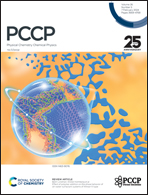Separation of protein corona from nanoparticles under intracellular acidic conditions: effect of protonation on nanoparticle–protein and protein–protein interactions
Abstract
Protein coronas separate from nanoparticles under intracellular acidic conditions however, competitive adsorption of multiple proteins and their protein network formation under different pH conditions have not yet been systematically studied at the atomic scale. Herein, we report all-atom molecular dynamics simulations of plasma proteins (human serum albumin and immunoglobulin gamma-1 chain C) adsorbed to 10 nm-sized carboxyl-terminated polystyrene (PS) nanoparticles at different protonation states that mimic extracellular and intracellular pH conditions of 7, 6–5, and 4.5. Binding free energies are calculated from umbrella sampling simulations, showing the significantly weakened binding between PS particles and proteins at the protonation state at pH 4.5, in agreement with experiments showing the separation of protein corona from nanoparticles at pH 4.5. Mixtures of multiple proteins and PS particles are also simulated, showing much less protein adsorption and protein cluster formation at the protonation state at pH 4.5 than that at higher pH values, which are further confirmed by calculating the diffusivities and hydrodynamic radii of individual proteins. In particular, electrostatic particle–protein and protein–protein interactions are significantly weakened by a combination of particle and protein protonation rather than by particle protonation alone, to an extent dependent on different proteins. These findings help explain the experimental observations regarding separation of protein corona from nanoparticles under intracellular acidic conditions at pH 4.5 but not at higher pH, supporting that acidification cannot be the only reason for this separation during the process of endosome maturation.



 Please wait while we load your content...
Please wait while we load your content...